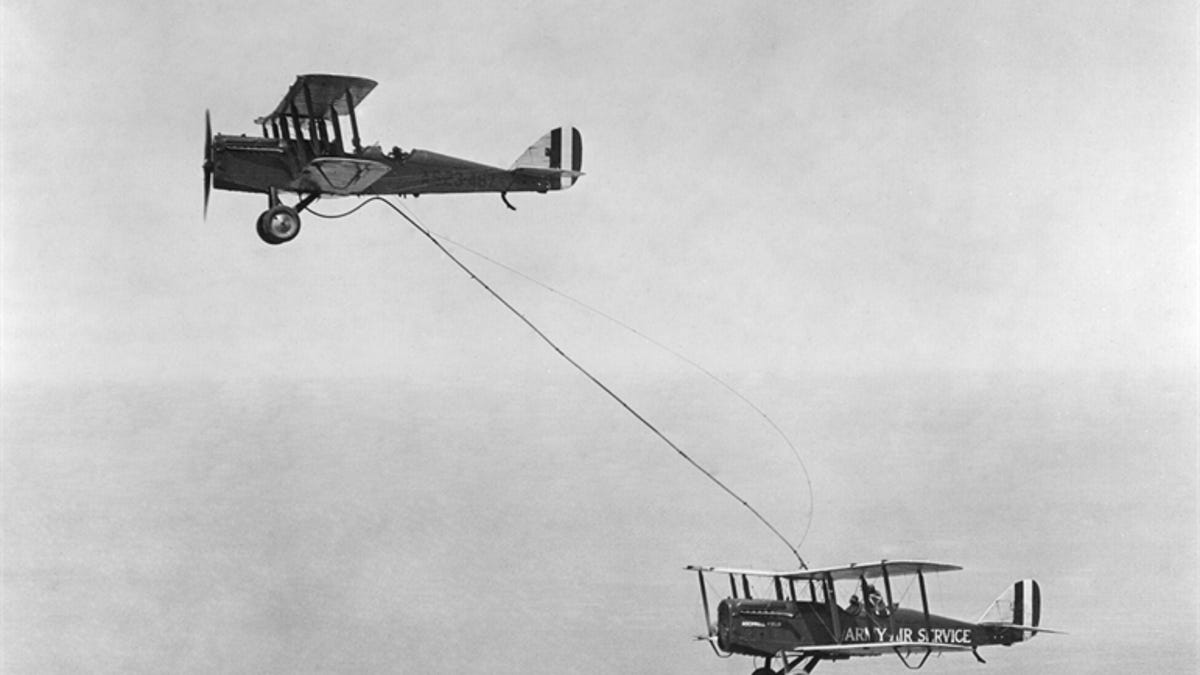Fill 'er up, flyboy: Sky-high refueling, from biplane to B-2
Ninety years ago, a handful of aviators tried out a novel idea: running a gasoline hose from one biplane to another. Higher-tech adaptations of that maneuver keep 21st century aircraft going and going and...

If you were to have gazed up into the skies above San Diego's Rockwell Field on a late August day in 1923, you'd have seen aviation history in the making.
On August 27 and 28 of that year, Army Air Service pilots Lowell Smith and John Richter, flying in a DeHavilland DH-4 biplane, were engaged in an endurance flight that ended up lasting 37 hours, 15 minutes, a world record at that time. And here's where the achievement gets really interesting: they were able to stay aloft for so long because another DH-4 regularly came by to run out a hose and transfer fuel in midair.
Altogether in that day and a half, the two biplanes had 16 refueling contacts, and Smith and Richter set a total of 16 world records for distance, speed, and duration.
Two months earlier, in late June 1923, those same two flyboys had been on the receiving end of the very first midair refueling, also between two DH-4 aircraft. Smith was in the pilot's cockpit, while Richter grappled with the hose. (In the "tanker" aircraft, the pilot in the front cockpit was Virgil Hine, and Frank Seifert doled out the hose from the rear cockpit.)You can see that achievement in the amazing photo above.
(Some readers might quibble that the June 1923 flight marked the first practical midair refueling. Certainly, this was the method that set the stage for all later technological developments in the field, even as the essence of the system -- one aircraft passes a hose (or a tube) to another aircraft -- remains the same. But a year and a half earlier, in November 1921, there was a jaw-dropping precursor, when wingwalker Wesley May strapped a 5-gallon gas can to his back and transferred himself ever so carefully from a Lincoln Standard biplane to a Curtiss Jenny, wingtip to wingtip, 1,000 feet above the ground.)
Ninety years later, aerial refueling has long since become SOP for military aircraft, enabling some striking feats of endurance. In March, for instance, the US Air Force sent B-2 Spirit bombers on a 13,000-mile round trip from Missouri to South Korea and back, ostensibly for a training exercise over the ideologically divided peninsula, but also quite clearly for a little geopolitical muscle-flexing in response to go-nuclear noise from a North Korean regime.
As new aircraft technologies take to the air, they too will have to learn the skills of midair refueling. In its KQ-X project that wrapped up in September 2012, DARPA investigated the potential for autonomous midair refueling with a pair of RQ-4 Global Hawk UAVs. No actual refueling took place, but the two aircraft did operate safely in close proximity and provided Pentagon researchers with stacks of performance data.
The Navy, meanwhile, had been hoping that in 2014 it would carry out aerial refueling tests with its X-47B drones -- the same ones that just showed they can land on and take off from an aircraft carrier -- but it looks now like that experiment will not come to pass anytime soon.
On Friday, Boeing said it has officially begun assembling a second KC-46A Tanker, loading the aircraft's 82-foot wing spar into an Automated Spar Assembly Tool, two months after beginning assembly of the first KC-46A. "One year from now, all four test aircraft will be out of the factory, and the first two will be flying," Boeing Vice President Maureen Dougherty said in a statement.
The KC-46A is based on Boeing's commercial 767 jetliner, though the aerospace titan has said that the tanker will feature a "modern, digital flight deck" that's based on the electronic displays in its new 787 Dreamliner.
Boeing on Friday laid out this timetable for the KC-46A: "The first test aircraft is expected to roll out of the factory in January 2014, while the second is scheduled to leave the factory in March. Boeing plans to fly the fully provisioned tanker for the first time in early 2015 and make the first delivery in 2016. The company expects to build and deliver the first 18 KC-46As by 2017 and a total of 179 by 2027 if all options under the contract are exercised."
If Boeing does hit all those milestones, it will be in line for a total $30 billion payout. Big business indeed, born of the scrappy can-do efforts of four men and two biplanes.

